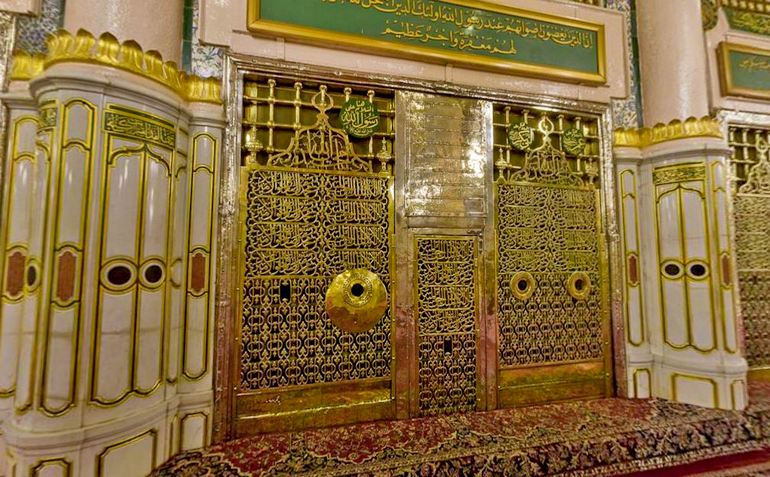This golden grill is the front of Rawdah Mubarak, the Sacred Room in which the Prophet Mohammed died (SAW) and where he is buried. There are also the graves of the first two caliphs of Islam, Abu Bakr (may Allah be pleased with him) and Umar (may Allah be pleased them).
Regarding visiting Medina and making Ziyara (visiting the grave of the Holy Prophet (SAW), the Prophet (SAW) said: “Anyone who visits me after my death looks like someone who visited me during my life.” [Tabraani] “He who performs his hajj in Mecca, then comes to Medina for the sole purpose of visiting me in my Masjid, for the two accepted Hajj will be written (awards) for him.”
[Daylami] “When a person stands at my grave, uttering blessings to me, I hear it; and whoever asks for bless on me in any other place, his every need in this world and in the hereafter will be fulfilled, and on the day of Kiyama I will be his witness and protector. ” [Bayhaqi]
Inspection holes above are aligned with the faces of the inhabitants of the graves. The largest hole on the left directly faces the noble face of the Prophet Muhammad (saw). The one in the middle is aligned with the face of Abu Bakr (may Allah be pleased with him), and the one who is on the right is aligned with the face of Umar (may Allah be pleased with him).

The Prophet (SAW) was buried in the house of Aisha (may Allah be pleased with her) in the house in which he was at the time of his death. The wives of the Prophet (SAW) lived in small simple huts adjoining the mosque. Each hut consisted of a room about 5 x 4 m in size with a small backyard, which was made of unfired clay bricks with palm branches as roofing.
On the left side of the hut of Aisha (may Allah be pleased with her) was the hut of Saud (Allah may be pleased with her), the Prophet’s second wife (SAW). The hut of Hafsa (may Allah be pleased with her), the other wife of the Prophet (SAW) and the daughter of Umar (may Allah be pleased with him) were on the opposite side. Previously, there was a very narrow street between their houses, which was enough for one person to pass through it. Aisha (may Allah be pleased with her) and Hafsa (may Allah be pleased with her) communicate with each other sitting in their own huts. Part of the Hafsa hut (may Allah be pleased with it) was located inside the current Sacred Chamber, and the part where visitors stand to greet the Prophet (SAW).
In 91 A.H. Umar bin Abdul Aziz (may Allah forgives him) built five corner walls so that no one could enter the Sacred Chamber. After several conspiracies were uncovered to steal the body of the Prophet (SAW) by digging under the graves, Sultan Nurruddin Zengi built a trench around the chamber, which was filled with molten lead.
The death and burial of the Prophet (SAW)
In Muharram 11 AH. The Prophet (SAW) developed a temperature that continued to rise, and he became more and more sick by the day. He asked his wives for permission to stay in Aisha’s room (may Allah be pleased with her), whom they willingly acceded. On Monday, 12 Rabi al-Avval, he came out with a bandage on his head. Abu Bakr (may Allah be pleased with him) led the salah and retreated, but the Prophet (SAW) gestured for him to end the prayer.
Among the last advice given by the Prophet (SAW) was the importance of prayer and fair treatment of slaves and servants. In conclusion, he said: “I leave two things with you. As long as you hold them tight, you never go astray; This is the Book of Allah (the Quran) and my sunnah. ”
The Prophet (SAW) became weaker and eventually died in the second half of the day on Monday, 12 Rabiul-Awal, 11 AH (633 AD).

The companions offered memorial prayers individually, without an imam. People said: “Bury him near the pulpit.” Others said, “Bury him in Baqi.” Then Abu Bakr came (may Allah be pleased with him) and said: “I heard the Prophet of Allah (SAW) say:” The Prophet was never buried except in the place where he died. ” Thus, the grave was dug under the bed in the room, and while they bathed him, they intended to take off his shirt, and a voice came out: “Do not take off the shirt.” Then bathed with his shirt. [Muwatta Malik]
The death and burial of Abu Bakr (may Allah be pleased with him)
Caliph Abu Bakr (may Allah be pleased with him) left a will with his daughter Aisha (may Allah be pleased with her) to bury him next to the Prophet (SAW). He died in Jamad al-Ukhr at 13 A.H. at the age of 63, the same age as the Prophet (SAW) at the time of his death. During the fifteen days of illness, Umar (may Allah be pleased with him) led Salah. Abu Bakr (may Allah be pleased with him) was a caliph for about two and a half years.
Death and burial of Umar (may Allah be pleased with him)
Khalif Umar bin Al-Khattab (may Allah be pleased with him) was slaughtered by a Persian slave named Firoz (also known as Abu Lulu), who then committed suicide. Shortly before his death, he told his son Abdullah: “Go to the mother of believers, Aisha (may Allah be pleased with her), and say:“ Umar bin Al-Khattab sends you his greetings ”and asks her: let me be buried with my companions. ” Aisha (may Allah be pleased with her) said: “I had an idea to have this place for myself, but today I will give him preference over myself.” When he returned, he said that: “She allowed you (to be buried there).” To this, Umar (may Allah be pleased with him) said: “For me, there is nothing more important than being buried in this (sacred) place.” He died on Muharram 1, 24 AH, his tenure as Caliph lasted ten and a half years. Suhayb (may Allah be pleased with him) led his funeral prayer. After the funeral of Umar (may Allah be pleased with him) in the Sacred Chamber, Aisha (may Allah be pleased with him) placed a partition between the area occupied by the graves and the rest of the room, as Umar (may Allah be pleased with) was not mahram to her.
In the Sacred Chamber there is a place for the fourth grave, where Jesus (may he) [Jesus] eventually be buried. Tirmidhi mentions as Abdullah bin Salam tells (may Allah be pleased with him): “The characteristics of the Prophet Muhammad (SAW) are described in the Old Testament, and it also mentions that Isa (peace be upon him) would be buried with him.
The video below shows a 3D visualization of the Sacred Chamber and its surroundings:
Sources: History of Madinah Munawwarah – Dr. Muhammad Ilyas Abdul Ghani, Virtues of Hajj – Sheikh Zakariyya Kandhalvi, The History of Islam – Akbar Shah Najeebabadi





